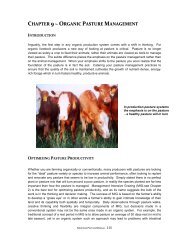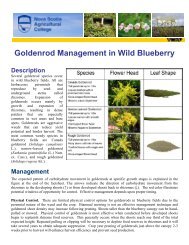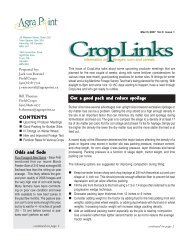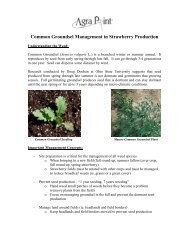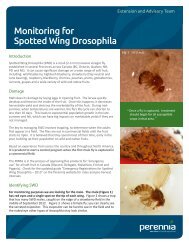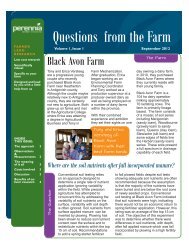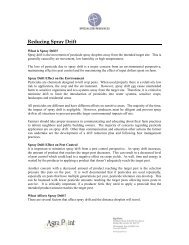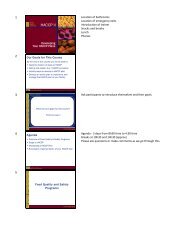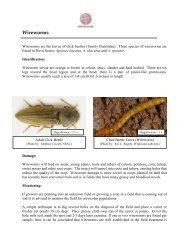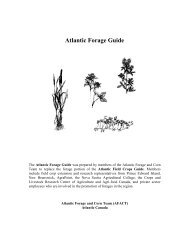Guide to Pest Management in Rhubarb 2013 - Perennia
Guide to Pest Management in Rhubarb 2013 - Perennia
Guide to Pest Management in Rhubarb 2013 - Perennia
You also want an ePaper? Increase the reach of your titles
YUMPU automatically turns print PDFs into web optimized ePapers that Google loves.
GUIDE TO PEST<br />
MANAGEMENT IN<br />
RHUBARB<br />
Nova Scotia Vegetable Crop <strong>Guide</strong> <strong>to</strong> <strong>Pest</strong> <strong>Management</strong> <strong>2013</strong><br />
[RHU1-13]<br />
Updated April 9, <strong>2013</strong> by<br />
Peter Burgess, Horticulturist, <strong>Perennia</strong><br />
Mélanie Leclerc, Research Assistant, <strong>Perennia</strong><br />
IMPORTANT<br />
This publication was compiled by representatives from <strong>Perennia</strong> us<strong>in</strong>g <strong>in</strong>formation from<br />
the <strong>Pest</strong> <strong>Management</strong> Regula<strong>to</strong>ry Agency of Health Canada, specific pesticide labels,<br />
previous Atlantic Prov<strong>in</strong>ces Vegetable <strong>Pest</strong> <strong>Guide</strong>s and manufacturer’s <strong>in</strong>formation. This<br />
<strong>in</strong>formation is cont<strong>in</strong>uously chang<strong>in</strong>g and therefore it can cease <strong>to</strong> be current and<br />
accurate. <strong>Pest</strong>icide labels are the best source of <strong>in</strong>formation and should always be<br />
consulted prior <strong>to</strong> us<strong>in</strong>g a product. The label is the best source of <strong>in</strong>formation on:<br />
registered crop uses, rates, days <strong>to</strong> harvest, compatibility with other pesticides, <strong>to</strong>xicity<br />
and other special <strong>in</strong>formation on its effective and safe use<br />
By pr<strong>in</strong>t<strong>in</strong>g this publication, <strong>Perennia</strong> does not offer any warranty or guarantee, nor do<br />
they assume any liability for any crop loss, animal loss, health, safety or environmental<br />
hazard caused by the use of a pesticide mentioned <strong>in</strong> this publication.<br />
WARNINGS<br />
This publication is meant <strong>to</strong> be used as a reference for possible pest control options.<br />
Where there are multiple brand names of a specific active <strong>in</strong>gredient registered <strong>in</strong><br />
Canada, <strong>Perennia</strong> has only listed a couple for reference purposes and as such does not<br />
endorse one brand over another. If you have purchased a generic product not specifically<br />
<strong>in</strong> this guide but has your crop and pest on the label, always follow that product label.<br />
If any <strong>in</strong>formation <strong>in</strong> this or any other publication conflicts with the <strong>in</strong>formation on<br />
the label, always use the label recommendation. If you have an old label, your<br />
pesticide supplier should be able <strong>to</strong> give you the newest label. You are legally<br />
responsible for the safe use of pesticides you purchase. This means the safe transport and<br />
s<strong>to</strong>rage of these materials, the label rates used on crops, and the safe disposal of<br />
conta<strong>in</strong>ers.<br />
<strong>Rhubarb</strong><br />
1
<strong>Pest</strong><br />
WEEDS:<br />
Group<br />
Active<br />
Ingredient<br />
<strong>Pest</strong>icide<br />
Product<br />
Name<br />
Rate<br />
Restricted-<br />
Entry<br />
Interval<br />
(REI)<br />
Preharvest<br />
Interval<br />
(days)<br />
Remarks<br />
Preplant<br />
<strong>Perennia</strong>l weeds<br />
<strong>in</strong>clud<strong>in</strong>g<br />
quackgrass<br />
9 glyphosate Roundup 356 Sn 1.25-2.5<br />
L/ha<br />
14 carfentrazoneethyl<br />
Roundup<br />
WeatherMAX<br />
1.67-8.0<br />
L/ha<br />
Touchdown 480 2.5-7.0<br />
L/ha<br />
Aim EC 36.5-117<br />
mL/ha<br />
-<br />
12 hours<br />
12 hours<br />
7<br />
7<br />
7<br />
Apply <strong>in</strong> the fall or spr<strong>in</strong>g<br />
prior <strong>to</strong> plant<strong>in</strong>g. Annual<br />
weed control programs will<br />
be necessary <strong>to</strong> control weeds<br />
germ<strong>in</strong>at<strong>in</strong>g after plant<strong>in</strong>g.<br />
For quackgrass control, apply<br />
<strong>to</strong> actively grow<strong>in</strong>g<br />
quackgrass when at least 4<br />
new leaves are present. The<br />
low rate (2.5 L/ha) will<br />
provide a m<strong>in</strong>imum of one<br />
season control, while higher<br />
rates (4.75 <strong>to</strong> 7 L/ha) will<br />
provide longer term control.<br />
The low rate of Roundup<br />
should be applied <strong>in</strong> 50 <strong>to</strong> 100<br />
L/ha water. If higher water<br />
volumes are used add a<br />
suitable surfactant. Wait 72<br />
hours before plow<strong>in</strong>g under.<br />
Best control of quackgrass is<br />
obta<strong>in</strong>ed when these<br />
herbicides are applied <strong>in</strong> the<br />
fall.<br />
12 hours 1 Apply <strong>in</strong> m<strong>in</strong>imum spray<br />
volume of 100 L/ha. Refer <strong>to</strong><br />
<strong>Rhubarb</strong><br />
2
Postemergence<br />
Inter-row<br />
shielded<br />
Established<br />
Pre-emergent <strong>to</strong><br />
crop, preemergent<br />
up <strong>to</strong><br />
2-leaf stage of<br />
weeds<br />
22 paraquat Gramoxone 200<br />
Sn<br />
2.75-5.5<br />
L/ha<br />
22 diquat Reglone 240 2.3-4.6<br />
L/ha<br />
14 carfentrazoneethyl<br />
Aim EC 36.5-117<br />
mL/ha<br />
label for target weeds, buffer<br />
zones and rates. Use high<br />
flow rate nozzles <strong>to</strong> apply the<br />
highest spray volume.<br />
12 hours - Avoid spray<strong>in</strong>g crop as<br />
damage may occur.<br />
24 hours -<br />
12 hours 1 Apply <strong>in</strong> m<strong>in</strong>imum spray<br />
volume of 100 L/ha. Refer <strong>to</strong><br />
label for target weeds, buffer<br />
zones and rates. Use high<br />
flow rate nozzles <strong>to</strong> apply the<br />
highest spray volume.<br />
27 mesotrione Callis<strong>to</strong> 480SC 0.3 L/ha 12 hours 42 Make only one application<br />
per year. Apply <strong>in</strong> 200 L/ha<br />
water at 206-300 kPa.<br />
CAUTION: Apply <strong>to</strong><br />
dormant (prior <strong>to</strong> spr<strong>in</strong>g<br />
greenup) rhubarb.<br />
Applications <strong>to</strong> rhubarb that<br />
is not dormant will result <strong>in</strong><br />
crop <strong>in</strong>jury. Ra<strong>in</strong>fall or<br />
irrigation after application<br />
may <strong>in</strong>crease the risk of<br />
<strong>in</strong>jury <strong>to</strong> emerg<strong>in</strong>g rhubarb.<br />
Repeated use of CALLISTO<br />
480SC Herbicide <strong>in</strong> low pH<br />
soils may cause <strong>in</strong>jury <strong>to</strong><br />
rhubarb plants. Wait at least<br />
18 months after the last<br />
CALLISTO 480SC Herbicide<br />
application <strong>in</strong> rhubarb before<br />
<strong>Rhubarb</strong><br />
3
INSECTS:<br />
replant<strong>in</strong>g rhubarb.<br />
Aphids 4 acetamiprid Assail 70 WP 86 g/ha 48 hours 7 Max 5 applications/yr. 12 hr<br />
re-entry<br />
4 imidacloprid Admire 240 0.73-1.3<br />
L/ha<br />
12 hours 45 Apply specified dosage <strong>in</strong> one<br />
of the follow<strong>in</strong>g methods:<br />
• Apply specified dosage <strong>in</strong><br />
2000 L/ha of water as a<br />
narrow (5 cm or less) surface<br />
band over seed l<strong>in</strong>e dur<strong>in</strong>g<br />
plant<strong>in</strong>g. Application should<br />
be made with sufficient water<br />
<strong>to</strong> ensure <strong>in</strong>corporation <strong>in</strong><strong>to</strong><br />
the root zone.<br />
• Subsurface side-dress on<br />
both sides of each row of<br />
seedl<strong>in</strong>gs or established<br />
transplants; apply <strong>in</strong> 200 L/ha<br />
of water. ADMIRE must be<br />
<strong>in</strong>corporated <strong>in</strong><strong>to</strong> root-zone.<br />
• Post-seed<strong>in</strong>g drench,<br />
transplant-water drench, or<br />
hill drench; use higher water<br />
volumes - sufficient <strong>to</strong><br />
thoroughly wet the soil.<br />
Do not apply more than<br />
9C Flonicamid Beleaf 50SG 0.12-0.16<br />
kg/ha<br />
once per season.<br />
12 hours 0 days Thorough spray coverage of<br />
plant foliage is essential.<br />
M<strong>in</strong>imum of 94 litres of<br />
water/ha. Maximum of 3<br />
applications per season, allow<br />
<strong>Rhubarb</strong><br />
4
Aphids and<br />
Whiteflies<br />
4 thiamethoxam<br />
NEW 2012<br />
7 days between applications.<br />
Avoid overnight s<strong>to</strong>rage of<br />
spray mixtures, do not use<br />
liquid fertilizer as a carrier<br />
and do not use adjuvants.<br />
Actara 25 WP 105 g/ha 12 hours 7 Apply before aphids reach<br />
damag<strong>in</strong>g levels. Maximum<br />
two applications per year.<br />
This product is highly <strong>to</strong>xic<br />
<strong>to</strong> bees, do not apply <strong>to</strong><br />
bloom<strong>in</strong>g crops and wait at<br />
least 5 days before plac<strong>in</strong>g<br />
beehives <strong>in</strong> a treated field.<br />
Allow at least 7 days between<br />
23 spirotetramat Moven<strong>to</strong> 240 SC 220-365<br />
ml/ha<br />
Moven<strong>to</strong> 150 OD 347-585<br />
ml/ha<br />
applications.<br />
12 hours 3 M<strong>in</strong>imum <strong>in</strong>terval between<br />
applications is 7 days.<br />
Maximum of 730 ml/ha of<br />
product applied per season.<br />
This product is TOXIC <strong>to</strong><br />
bees through direct<br />
contam<strong>in</strong>ation of pollen and<br />
nectar. DO NOT apply this<br />
product dur<strong>in</strong>g crop<br />
flower<strong>in</strong>g period or when<br />
flower<strong>in</strong>g weeds are present<br />
<strong>in</strong> the field, orchard or<br />
v<strong>in</strong>eyard.<br />
12 hours 3 M<strong>in</strong>imum <strong>in</strong>terval between<br />
applications is 7 days.<br />
Maximum of 1.17 L/ha of<br />
product applied per season.<br />
This product is TOXIC <strong>to</strong><br />
<strong>Rhubarb</strong><br />
5
Cabbage<br />
looper,<br />
Imported<br />
cabbage worm,<br />
&<br />
Diamondback<br />
moth<br />
bees through direct<br />
contam<strong>in</strong>ation of pollen and<br />
nectar. DO NOT apply this<br />
product dur<strong>in</strong>g crop<br />
flower<strong>in</strong>g period or when<br />
flower<strong>in</strong>g weeds are present<br />
<strong>in</strong> the field, orchard or<br />
v<strong>in</strong>eyard.<br />
5 sp<strong>in</strong>osad Success 480 SC 0.182 L/ha 12 hours 1 Max 3 applications/yr. Allow<br />
7-10 days between<br />
applications<br />
Entrust 80 W 109 g/ha 12 hours 1 Max 3 applications/yr. Allow<br />
7-10 days between<br />
5 sp<strong>in</strong>e<strong>to</strong>ram Delegate WG 140-200<br />
g/ha<br />
applications<br />
4 hours 1 Time application for<br />
Cabbage Looper with peak<br />
egg hatch or small larvae.<br />
Repeat applications based on<br />
population moni<strong>to</strong>r<strong>in</strong>g. Use<br />
higher rate for higher<br />
<strong>in</strong>festations or advanced<br />
growth stages. Maximum of 3<br />
applications per year with a<br />
m<strong>in</strong>imum re-treatment<br />
<strong>in</strong>terval of 5 days.<br />
28 chlorantraniliprole Coragen 250 ml/ha 12 hours 1 For Cabbage Looper. Beg<strong>in</strong><br />
applications when treatment<br />
thresholds have been reached.<br />
Maximum of 4 applications<br />
per season. Do not apply<br />
more than once every 3 days.<br />
Do not exceed 1 L of Coragen<br />
per ha per season. Apply <strong>in</strong> a<br />
<strong>Rhubarb</strong><br />
6
Tarnished<br />
Plant Bug<br />
DISEASES:<br />
4 thiamethoxam<br />
NEW 2012<br />
f<strong>in</strong>ished spray volume of<br />
100L/ha.<br />
Actara 25 WP 210 g/ha 12 hours 7 Apply before aphids reach<br />
damag<strong>in</strong>g levels. Maximum<br />
one application per year. This<br />
product is highly <strong>to</strong>xic <strong>to</strong><br />
bees, do not apply <strong>to</strong><br />
bloom<strong>in</strong>g crops and wait at<br />
least 5 days before plac<strong>in</strong>g<br />
beehives <strong>in</strong> a treated field.<br />
Botrytis leaf<br />
rot<br />
(<strong>in</strong> forc<strong>in</strong>g<br />
sheds)<br />
M captan Captan 80 WDG<br />
Maestro 80 DF<br />
1.4-2.0<br />
kg/ha<br />
1.25-2.0<br />
kg/ha<br />
Gray Mold 7 penthiopyrad Fontelis 1.25-1.75<br />
L/ha<br />
NEW 2012<br />
Sclerot<strong>in</strong>ia<br />
White Mold<br />
(Sclerot<strong>in</strong>ia<br />
spp.)<br />
7-11 boscalid,<br />
pyraclostrob<strong>in</strong><br />
Prist<strong>in</strong>e WG 1.0 – 1.3<br />
Kg/ha<br />
48 hours 2 Spray at weekly <strong>in</strong>tervals <strong>in</strong><br />
1000L of water. 48 hr reentry.<br />
48 hours 2<br />
12 hours 3 Beg<strong>in</strong> applications prior <strong>to</strong><br />
disease development,<br />
cont<strong>in</strong>ue on a 7-10 day<br />
<strong>in</strong>terval. Use higher rate and<br />
shorter <strong>in</strong>terval when disease<br />
pressure is high. Max<br />
seasonal rate is 5.25 L/ha. Do<br />
not make more than 2<br />
sequential applications before<br />
switch<strong>in</strong>g <strong>to</strong> another mode of<br />
action.<br />
- 0 For suppression of white<br />
mold. Apply once per season<br />
before disease develops. REI<br />
= 24hrs. For hand harvest<strong>in</strong>g<br />
and th<strong>in</strong>n<strong>in</strong>g <strong>in</strong> leafy<br />
vegetables do not enter for 9<br />
<strong>Rhubarb</strong><br />
7
7 penthiopyrad<br />
NEW 2012<br />
Fontelis 1.25-1.75<br />
L/ha<br />
days after application.<br />
12 hours 3 Beg<strong>in</strong> applications prior <strong>to</strong><br />
disease development,<br />
cont<strong>in</strong>ue on a 7-10 day<br />
<strong>in</strong>terval. Use higher rate and<br />
shorter <strong>in</strong>terval when disease<br />
pressure is high. Max<br />
seasonal rate is 5.25 L/ha. Do<br />
not make more than 2<br />
sequential applications before<br />
switch<strong>in</strong>g <strong>to</strong> another mode of<br />
action.<br />
Use the follow<strong>in</strong>g web l<strong>in</strong>k <strong>to</strong> search for any pesticide label mentioned <strong>in</strong> this guide, or any other pesticide<br />
registered <strong>in</strong> Canada:<br />
http://pr-rp.hc-sc.gc.ca/ls-re/<strong>in</strong>dex-eng.php<br />
<strong>Rhubarb</strong><br />
8
PESTICIDE EMERGENCY CONTACT<br />
INFORMATION<br />
Poison Control Centres<br />
Nova Scotia 800.565.8161 or 902.428.8161 IWK, Halifax, NS<br />
New Brunswick 911 Ask for Poison Information<br />
Pr<strong>in</strong>ce Edward Island 800.565.8161 or 902.428.8161 IWK, Halifax, NS<br />
Newfoundland 709.722.1110 Dr. Charles A. Janeway Child<br />
Health Care Centre,<br />
St. John’s, NF<br />
Environmental Emergencies (<strong>Pest</strong>icide Spills)<br />
Transport Canada Regional Operations Centre (24 hours)<br />
Nova Scotia 800.565.1633<br />
New Brunswick 800.565.1633<br />
Pr<strong>in</strong>ce Edward Island 800.565.1633<br />
Newfoundland 800.563.9089<br />
ABBREVIATIONS & CONVERSIONS<br />
Formulation and Measurement Abbreviations<br />
FORMULATIONS<br />
MEASUREMENTS<br />
DF Dry flowable mL millilitre<br />
SC Suspension concentrate kPa kilopascal<br />
Sn Solution kg kilogram<br />
WDG Wettable dry granule g gram<br />
WP, W Wettable powder L litre<br />
BIU Billions of International Units<br />
ppm parts per million (1000 ppb)<br />
ppb parts per billion (1/1000 ppm)<br />
Helpful Conversions 1<br />
kPa X 0.14 = pounds per square <strong>in</strong>ch (psi)<br />
hectares X 2.47 = acres<br />
kilograms X 2.2 = pounds<br />
kilograms per hectare X 0.89 = pounds per acre<br />
kilograms per hectare X 0.40 = kilograms per acre<br />
millilitres X 0.035 = fluid ounces<br />
litres X 35 = fluid ounces<br />
litres X 0.22 = imperial gallons<br />
litres per hectare X 14.17 = fluid ounces per acre<br />
litres per hectare X 0.40 = litres per acre<br />
degree-days C X 1.8 = degree-days F<br />
1 <strong>Pest</strong>icide Units of Measurement<br />
It is not recommended <strong>to</strong> convert label rates <strong>to</strong> imperial units because there is a high probability of mathematical and<br />
round<strong>in</strong>g errors. Present day pesticides are formulated <strong>to</strong> be more effective <strong>in</strong> smaller amounts. Therefore, even small<br />
conversion errors can lead <strong>to</strong> the use of <strong>in</strong>correct rates (either <strong>to</strong>o high or <strong>to</strong>o low). Use metric – you will be glad you did!<br />
<strong>Rhubarb</strong><br />
9



